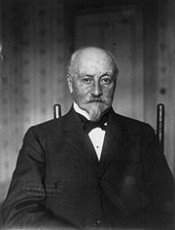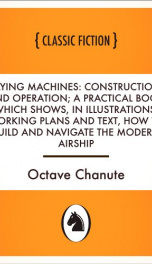Chanute Octave

Octave Chanute (February 18, 1832 – November 23, 1910) was a French-born American railway engineer and aviation pioneer. He provided the Wright brothers with help and advice, and helped to publicize their flying experiments. Octave Chanute was widely considered a brilliant and innovative railroad engineer.[who?] During his career he designed and constructed the country's two biggest stock yards -- Chicago Stock Yards (1865) and Kansas City Stockyards (1871). He designed and built the Hannibal Bridge which was the first bridge to cross the Missouri River in Kansas City, Missouri in 1869. The bridge established Kansas City as the dominant city in the region. He also designed the Illinois River rail bridge at Peoria, and the Genesee River Gorge rail bridge near Portageville, New York. Chanute invented a system for pressure treating rail ties and telephone poles with creosote to preserve them. He also introduced the railroad date nail into the United States - a simple and efficient way of recording the age of railroad ties and other wooden structures by date stamping the heads of nails. Chanute first became interested in aviation during a visit to Europe in 1875. When he retired from his engineering business in 1890, he decided to devote his time to furthering the new science of aviation. Following his systematic engineering background, Chanute first collected all the data that he could find from flight experimenters around the world. He published this as a series of articles first published in The Railroad and Engineering Journal from 1891 to 1893, and collected together in Progress in Flying Machine in 1894. This was the first organised, written collection of aviation research. At the World's Columbian Exposition in Chicago in 1893, Chanute organized a highly successful International Conference on Aerial Navigation. Chanute was too old to attempt to fly himself. However, he worked in partnership with younger experimenters, including Augustus Herring and William Avery. In 1896 and 1897 Chanute, Herring and Avery tested hang gliders based on designs by German aviator Otto Lilienthal, as well as hang gliders of their own design, on the shores of Lake Michigan in the town of Miller Beach not far from what would become the city of Gary, Indiana. These experiments convinced Chanute that the best way to achieve extra lift without a prohibitive increase in weight was to stack several wings one above the other, an idea proposed by British engineer Francis Wenham in 1866 and realized in flight by Lilienthal in the 1890s. Chanute invented the "strut-wire" braced wing structure that would be used in powered biplanes of the future. He based the design on the Pratt truss, familiar to him from his bridge-building work. The Wright brothers, in turn, based their glider and Flyer designs on the Chanute "double-decker," as they called it. Chanute corresponded with many aviation pioneers, including Louis Mouillard, Gabriel Voisin, John J. Montgomery, Louis Blériot Ferdinand Ferber, Lawrence Hargrave and Alberto Santos Dumont. In 1897 Chanute started a correspondence with British aviator Percy Pilcher. Following Chanute's ideas, Pilcher built a triplane, but he was killed in a glider crash before he could attempt to fly it. Chanute was in contact with the Wright brothers from 1900, when Wilbur Wright wrote to him after reading Progress in Flying Machines. Chanute helped to publicise the Wright brothers' work, and provided consistent encouragement, visiting their camp near Kitty Hawk in 1901, 1902 and 1903. Chanute freely shared his knowledge about aviation with anyone who was interested and expected others to do the same, although he did encourage colleagues to patent their inventions. His open approach led to friction with the Wright brothers, who believed their ideas about aircraft control were unique and refused to share them. Chanute did not believe the Wright flying machine patent, premised on wing-warping, could be enforced and said so publicly. The friendship was still impaired when Chanute died in 1910, although Wilbur Wright delivered the eulogy at Chanute's funeral. The town of Chanute, Kansas is named after him, as well as the former Chanute Air Force Base near Rantoul, Illinois, which was decommissioned in 1993. The former Base, now turned to peacetime endeavors, includes the Octave Chanute Aerospace Museum, detailing the history of aviation and of Chanute Air Force base. In 2003, as part of its commemoration of the 100th anniversary of the Wright Brothers' flight, Aviation Week & Space Technology named Chanute 38th on its list of the top 100 "most important, most interesting, and most influential people" in the first century of aerospace.[2]
do you like this author?
What readers are saying
What do you think? Write your own comment on this book!
write a commentWhat readers are saying
What do you think? Write your own comment on this author!
write a commentBook list

Flying Machines: construction and operation; a practical book which shows, in illustrations, working plans and text, how to build and navigate the modern airship
Series:
Unknown
Year:
Unknown
Raiting:
1.5/5
Octave Chanute was a railway engineer and aviation pioneer. He helped brothers Wright to advertise their flying experiments. He devoted his life to aviation. In 1893 Chanute organized a very successful International Conference on Aerial Navigation. Chanute was the first to invent "strut-wire" braced wing structure that would be used in powered biplanes of the future. Chanute communicated with many aviation pioneers, always seeking for new information. “Flying machines: construction and operation…” is the perfect work on building and navigating airships. The book contains a lot of descriptive illustrations and detailed explanations.
Show more
add to favoritesadd In favorites
Book list

Flying Machines: construction and operation; a practical book which shows, in illustrations, working plans and text, how to build and navigate the modern airship
Series:
Unknown
Year:
Unknown
Raiting:
1.5/5
Octave Chanute was a railway engineer and aviation pioneer. He helped brothers Wright to advertise their flying experiments. He devoted his life to aviation. In 1893 Chanute organized a very successful International Conference on Aerial Navigation. Chanute was the first to invent "strut-wire" braced wing structure that would be used in powered biplanes of the future. Chanute communicated with many aviation pioneers, always seeking for new information. “Flying machines: construction and operation…” is the perfect work on building and navigating airships. The book contains a lot of descriptive illustrations and detailed explanations.
Show more
add to favoritesadd In favorites
What readers are saying
What do you think? Write your own comment on this author!
write a commentGenre
if you like Chanute Octave try:
readers also enjoyed
What readers are saying
What do you think? Write your own comment on this author!
write a commentGenre
if you like Chanute Octave try:
readers also enjoyed
Do you want to read a book that interests you? It’s EASY!
Create an account and send a request for reading to other users on the Webpage of the book!

